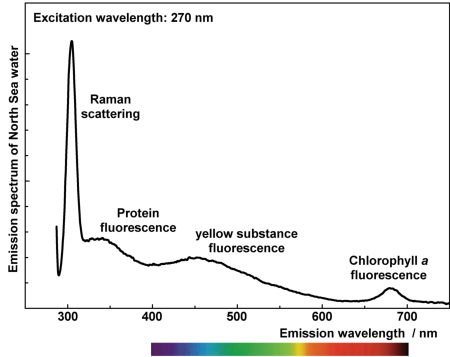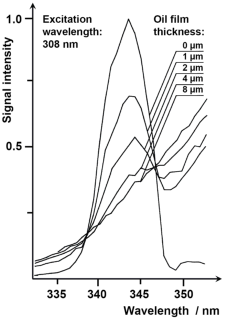7. Water Analysis Using Lidar
Detection of oil spills (2/4)
Measuring the film thickness of oil spills
Many substances which are present in clean waters exhibit characteristic signals when irradiated with laser light. One of these substances is Chlorophyll a, which is found as pigments in small algae, the so-called phytoplankton. It emits part of the absorbed light as fluorescence at 685 nm wavelength. Proteins bound to bacteria and algae fluoresce in the ultraviolet. Water-soluble humic substances which are produced by decaying plants on land are transported by river water into the sea; they are also produced at sea by decaying algae. Humic substances absorb light in the UV and blue, therefore they appear yellowish in daylight and are called yellow substances in marine science. Their fluorescence covers the entire visible spectrum.
Water molecules scatter light. Besides Rayleigh scattering which causes the blue colour of clean waters in sunlight, there is also another effect called Raman scattering. The Raman effect is characterised by an emission shift to wavelengths that are higher than the wavelength of the illuminating light. Thus, illumination of water with monochromatic laser light yields an emission spectrum showing a characteristic peak of Raman scattering, as shown in the graph below.

Depending on the concentration of algae and humic substances, these signals are observed when illuminating the sea surface with laser light using a laser fluorosensor aboard an aircraft. If oil is present on the water surface and the oil film is not too thick, the intensity of the signals from the water are reduced by partial absorption in the oil layer. The signals vanish if the oil films are so thick that the laser light is completely absorbed in the oil. A mathematical description of these processes can be found in Supplement 7.1.
As shown in the graph to the left, Raman scattering of water produces a characteristic narrow peak. Measuring its height allows to calculate the film thickness of oil on the water surface. Because of high absorbance of ultraviolet radiation in oil, films with micrometre thickness can be analysed, as shown in the graph below.

You will learn more about the molecular properties of Raman scattering in Supplement 7.3.
